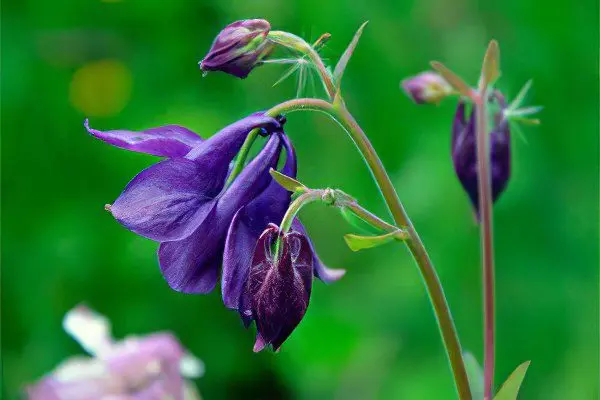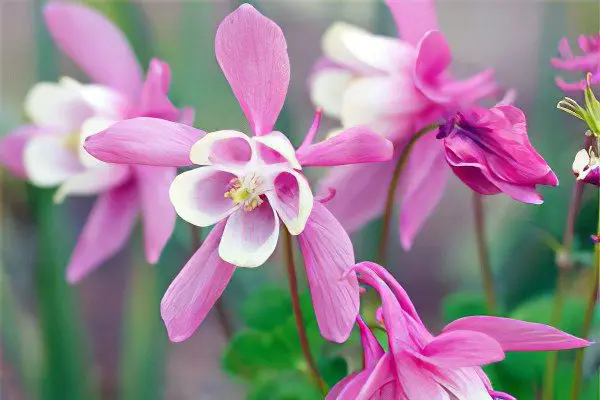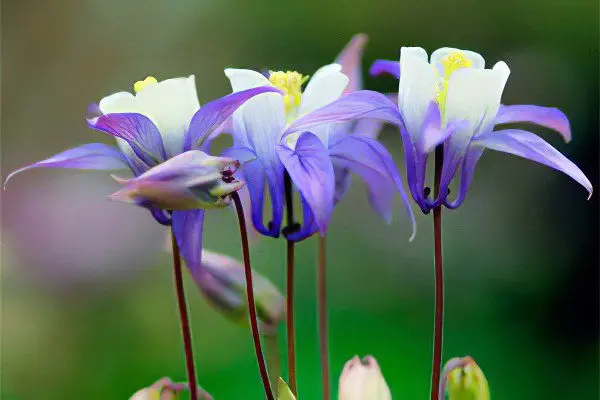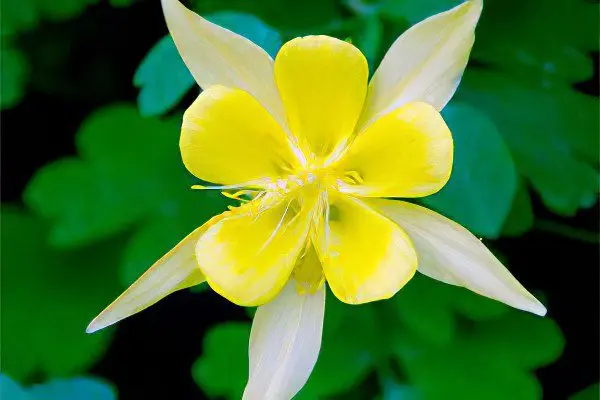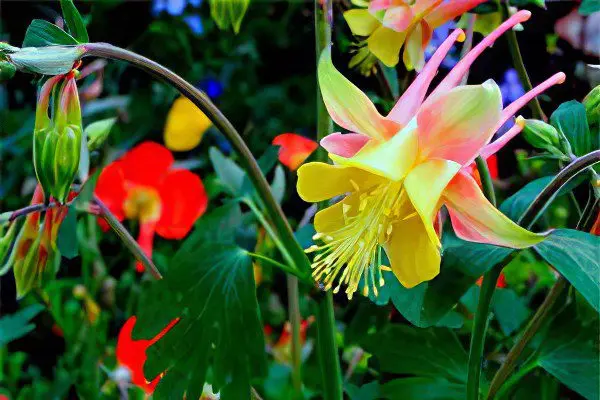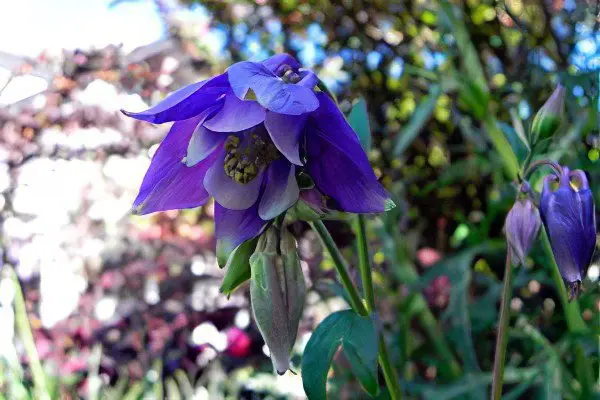Contents

Aquilegia flower is a perennial herb from the buttercup family. The Latin name of the culture sounds like “Aquilegia”. The people call the flower an eagle or a catchment. Until now, there are disputes regarding the origin of this word: there is an opinion that aquilegia is a derivative of “aqua”, that is, water, and “legere”, that is, to collect. The opposite point of view is that the name of the flower is related to the word “Aquila”, that is, an eagle.
Data on the number of species of this plant vary. Some scientists claim that only 60 are known to science, while others point to 120 varieties. The natural habitat of aquilegia is the mountainous regions of the Northern Hemisphere of the world. About 35 varieties of aquilegia have been cultivated.
Aquilegia is a fairly well-known flower. He is mentioned in such a great work of fiction as Hamlet, where Ophelia offers Columbine to Laertes. That’s what they call aquilegia in England.
Aquilegia was repeatedly depicted in the paintings of the Middle Ages. There, the flower has always acted as a symbol of the Holy Spirit.
Aquilegia flower – description
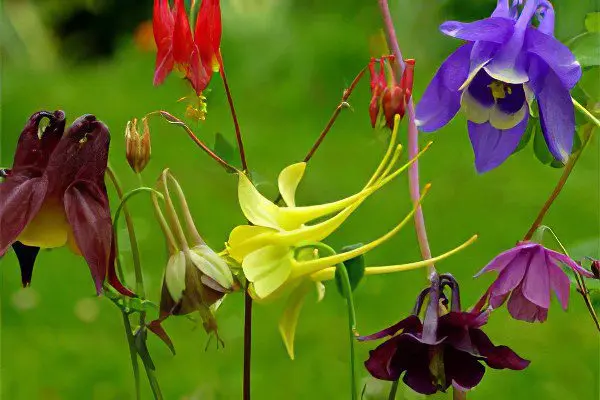
The development cycle of aquilegia includes two years. The first year of growth is characterized by the emergence of a renewal point, which is located at the base of the shoot. In autumn, when aquilegia fades, a rosette forms at this point. After the spring awakening of the flower, new leaves and peduncle appear from the outlet. From it in the future stem leaves and new flowers will go. The leaves that extend from the stems are trifoliate and sessile, and the leaves around the rosette are trifoliate-dissected, sitting on long petioles.
The plant produces flowers of various shades, depending on the type of aquilegia. You can find purple, crimson, blue, white, yellow and even multi-color flowers. Most of them have spurs with nectar (except Japanese and Chinese varieties of aquilegia). They are represented by outgrowths inside the sepals or petals.
Spurs are in such types of aquilegia as:
Alpine;
Olympic;
Ordinary;
Zhelezistaya;
Canadian;
blue;
Californian;
golden;
Aquilegia Skinner.
The flower bears fruit in multileaves. Aquilegia seeds are poisonous, small in size and black in color. You can get a new plant from seeds throughout the year, after which their germination deteriorates.
Growing aquilegia from seeds
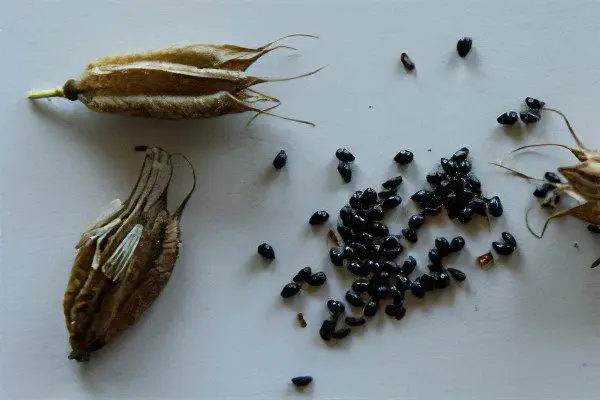
The optimal time for planting aquilegia seeds in the soil is autumn, immediately after they are collected. In the spring months, when the seeds have germinated, the flowers can be transplanted to their place of permanent growth.
If it is not possible to plant seeds in the ground immediately after collection, then they should be stored in a dark and cool place. They are mixed with earth and kept in the refrigerator. In mid-spring, the seeds will need to be cleared of soil. Then they are planted in wooden boxes filled with humus, leaf earth and sand in equal parts. After the seeds are placed in the ground, they are sprinkled with earth, sifting it through a sieve. The layer of earth should not exceed 3 mm. A newspaper or cloth is laid out on top of the box.
Then the seed boxes are removed to a dark place where the temperature is maintained at 18 ° C. Seeds are not watered, but as the soil dries, it is necessary to moisten it by spraying. As a rule, seedlings are observed after 7-14 days. It is possible to transplant seedlings into open ground after the appearance of the first true leaves.
Landing aquilegia

In the first summer month, you can transplant flowers into open ground. This is done for the maturation of the plant. The scorching summer sun should not be allowed to fall on the young aquilegia. To do this, the flowers need to be shaded. Aquilegia is relocated to a permanent “place of residence” either in August, or in May or April the following year. In a new place, the plant will give color for several years.
Adult aquilegia are not afraid of the sun, but they feel quite good in the shade. The first flowers can be seen already next year, and in the third year of life, the aquilegia will reach maturity.
Any soil is suitable for planting a plant, but it feels best in a humus soil. Before planting flowers, the soil must be dug up and compost or humus added to it. For 1 cubic meter you will need 1 bucket of fertilizer. Aquilegia does not like too dense settlement. Therefore, there should not be more than 12 stems per square meter. If plant varieties with a high stem were selected, then the distance between them should be about 0,4 m, if the stems are low, then about 0,25 m.
It should be remembered that the flowers themselves throw off the seeds into the ground, so you will have to periodically remove self-sowing. Although some summer residents leave such flowers. Indeed, after a few years, the first landing will lose its former beauty. Old stems can be dug up, and new and young ones can be left.
Aquilegia – plant care
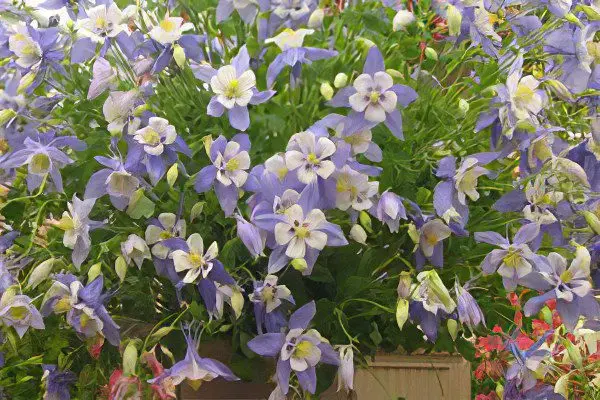
Aquilegia prefers moderate watering. The flower has a powerful root system, which is able to independently extract moisture from the deepest layers of the soil. Therefore, a lack of fluid can be observed only in very dry months.
It is important to weed the soil in a timely manner, preventing weeds from growing. After rain or after watering, the earth must be loosened. This is especially true for the first months of flower life.
Fertilizers need to be applied to the soil, but this should not be done too often. Enough 2 top dressing for 3 months. When the flower grows, you can add minerals: superphosphate (50 g), potassium salt (15 g), saltpeter (25 g) and mullein (per 1 square meter bucket of solution). After 1,5 months, top dressing must be repeated.
It is very easy to propagate the flower from cuttings. In early spring, until the first leaves appear, the shoot must be cut out, poured over the lower part with Kornevin, and then placed in a greenhouse or in open soil, but covered with plastic containers from above. Shoots feel very good in the shade, in river sand. Watering the young cuttings is carried out through a greenhouse. After 10 days, it is removed. It takes about a month for the plant to take root. After that, the flower can be carefully dug up and transplanted into permanent soil.
Pests and diseases of aquilegia

The most common diseases of aquilegia are:
Rust. When a flower is affected by rust, the damaged parts must be removed. Then the plant must be treated with soapy water with the addition of copper sulfate, or sprayed with preparations containing sulfur.
Gray rot. If the flower is affected by gray rot, then all damaged leaves and flowers should be removed as soon as possible. Sick parts of the plant must be burned. No drugs against gray rot work.
Powdery mildew. This disease affects the flower more often than others. The stem and leaves of the plant are covered with a fungal coating, after which they die. Aquilegia can be cured by treatment with colloidal sulfur with the addition of green soap.
As for pests, aphids, scoops, spider mites and nematodes most often start on flowers. Means such as Karbofos, Actellik and yarrow paste can effectively deal with ticks and aphids.
To get rid of nematodes, you will need to transplant the plant to another place. To prevent parasites from starting in a new planting, garlic or onions can be planted in a flower bed. Those flowers that have been affected by nematodes should be burned.
Aquilegia after flowering

After the color period has passed, the aquilegia must be cut to the very outlet. If the stems or leaves were susceptible to any disease, then they must be burned. Healthy parts of the plant can be used for compost.
When next year it is planned to propagate aquilegia by seed, the flower stalks should be left until the seeds ripen in them. So that the plant does not throw them off on its own, it is necessary to cover the flower stalks with gauze.
Also, after the flowering period, gardeners begin to divide and plant flowers. In the first month of autumn, seeds are introduced into the soil for germination for the next year.
Aquilegia in winter
When a plant lives in one place for more than three years, its root system grows strongly. The roots begin to come out of the soil, interfering with the growth of new shoots and leaves.
In order not to damage the plant and allow new flowers to grow, after cutting the peduncle, peat mixed with humus is poured under the aquilegia. This allows not only to cover the roots that have come out of the ground, but also to protect them from frost, and also to feed the flower.
Types of aquilegia
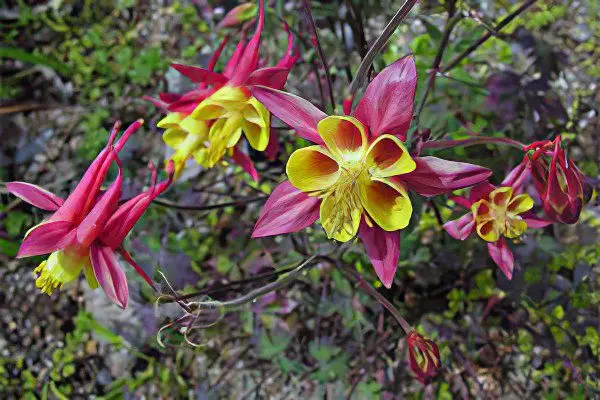
There are many types of aquilegia growing in natural conditions. In this case, the following plant varieties are most often cultivated:
Alpine aquilegia. The flower stem does not exceed 0,3 m in height, although there are plants up to 0,8 m. Alpine aquilegia gives very beautiful and voluminous flowers that can reach 8 cm in diameter. They appear in early July. Flowers can have all shades of blue.
Fan-shaped aquilegia. This variety is also called Aquilegia Akita. The stem can reach a height of 0,6 m. The flowers acquire a delicate blue-lilac hue, the edges of the petals are bordered by a white stripe. One peduncle holds 1-5 flowers. This is a rather unpretentious plant that tolerates frost well and actively propagates by seeds.
Ordinary aquilegia. The plant reaches a height of 0,4-0,8 m, flowers in diameter reach up to 5 cm. The color of the petals covers the entire purple and blue gamut. Plants are cultivated with and without spurs, as well as with petals covered with terry. The plant is not afraid of cold winters and can withstand temperatures below -35 ° C.
Hybrid aquilegia. This type of flower is the result of crossing several varieties. Therefore, the height of the plant can reach 0,5-1 m. The flowers are most often large, the color of the petals varies widely.
Golden-flowered aquilegia. Flowers have a golden hue and long spurs. The plant tolerates dry summers and frosty winters equally well. Rare in Russia.
Canadian aquilegia. Flowers have upright growing spurs, petals of a red-yellow hue. The plant prefers shady glades, does not tolerate drought. Until now, Canadian aquilegia has not found wide distribution among Russian gardeners.
Dark aquilegia. The maximum height of the stem is 0,8 m. The leaves have a bluish tint, and the flowers are dark purple in color. In diameter, the flowers reach 4 cm. The spurs are short and curved, stamens are visible from the petals. The color of this variety of aquilegia is gaining early. The first flowers can be expected at the end of spring. The plant does well in partial shade. Due to its rich dark color, this aquilegia is a regular participant in various flower arrangements.
Olympic aquilegia. In height, this plant does not exceed 0,6 m. The stem is covered with thick fluff, the flowers have a bluish tint, and the spurs are very long. Olympic aquilegia begins to bloom in mid-May. The plant is widespread in Iran and the Caucasus.
Aquilegia Skinner. The plant tolerates frosts down to -12 ° C. It has red-yellow petals and straight spurs. Skinner’s aquilegia is common in North America. It is this region that is the birthplace of the plant.
Alpine aquilegia Fan-shaped aquilegia Ordinary hybrid aquilegia golden-flowered Canadian aquilegia Dark aquilegia Olympic aquilegia Aquilegia Skinner |
In addition, gardeners are interested in such types of aquilegia as:
blue;
acute sepal;
Two-tone;
small-colored;
Green-flowered, etc.
Aquilegia is the flower that certainly deserves to become an adornment of any suburban area.










